 THE MINERAL ARSENOPYRITE
THE MINERAL ARSENOPYRITE
- Chemistry: FeAsS, Iron Arsenide Sulfide
- Class: Sulfides and Sulfosalts
- Group:
Arsenopyrite Group - Uses: Important ore of arsenic, minor source of gold and as mineral specimens.
Specimens
Arsenopyrite makes attractive mineral specimens as well. It's well formed crsytals show a distinct and interesting crystal form. A typical crystal contains a diamond shaped dome atop a prismatic crystal. The crystals have sharp acute angles that are a marked contrast from other sulfides that generally have only obtuse angles.
PHYSICAL CHARACTERISTICS:
- Color is a brassy white to gray.
- Luster is metallic.
- Transparency: Crystals are opaque.
- Crystal System is orthorhombic; 2/m 2/m 2/m
- Crystal Habits include prismatic crystals with a diamond cross section terminated by either a steep dome (actually two of the four faces of a prism) or a less inclined dome, also short stubby crystals doubly terminated with domes. Twinning is common, often bending the crystal and sometimes forming crosses, x's or stars.
- Cleavage is distinct in two directions forming prisms.
- Fracture is uneven.
- Hardness is 5.5 - 6.
- Specific Gravity is approximately 6.1+ (heavier than average for metallic minerals)
- Streak is dark gray to black
- Other Characteristics: Striations on dome faces, bitter smell when powdered or broken.
- Associated Minerals are gold, siderite, pyrite and other sulfides.
- Notable Occurrences include Kyushu Island and Iname, Japan; Cornwall, England; Bolivia; Freiberg, Germany; Wawa area of Ontario, Canada and Valais, Switzerland.
- Best Field Indicators are crystal habit, cleavage, smell when struck, color and luster.
 Amethyst Galleries' Mineral Gallery MINERALS |
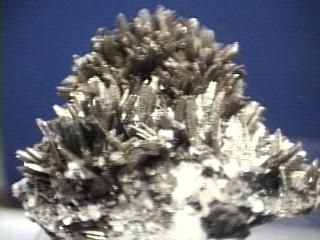
ARSENOPYRITE specimen ars-1
$ 90.00
$ 90.00
Dims: 3" x 3" x 1-1/2"
Wt: 13.8 oz
Canchaque Mine, Ancash, Peru
What may first appear to be metallic needles akin to Dogtooth Calcite are actually the Arsenopyrite crystals that are crammed onto this Peruvian piece. Maximum crystal length is only about 1/2 inch long, but there are positively dozens of them, along with a disarray of tiny quartz crystals and clusters, and just a scad of sphalerite to give the collector something to search for. This is one of our better specimens of a definitely distracting mineral.

ars-1 ($ 90.00)
Canchaque Mine, Ancash, Peru
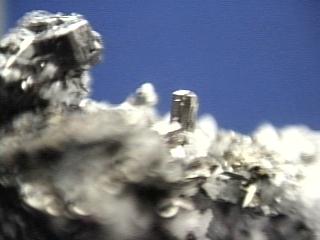
ARSENOPYRITE specimen ars-2
$ 70.00
$ 70.00
Dims: 2-1/2" x 2-1/2" x 1"
Wt: 5.3 oz
Pachapaqui Mine, Ancash, Peru
"Variety" is the key word I use when describing this specimen. Besides the obligatory 1/4 to 3/8 inch prismatic and dogtooth crystals of Arsenopyrite, there is a veritable "sulfide stew," containing Pyrite and big, clunky Sphalerite crystals, one or two of which seem to have partial coatings of a metallic(Chalcopyrite?) dust on a face. All of this is accompanied by a minor infestation of small, milky quartz crystals. A great specimen for those who like a lot of action!

ars-2 ($ 70.00)
Pachapaqui Mine, Ancash, Peru
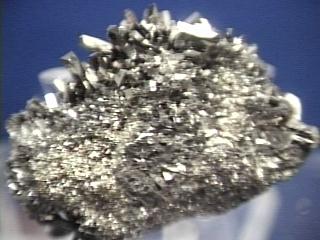
ARSENOPYRITE specimen ars-3
$ 50.00
$ 50.00
Dims: 2" x 1" x 1"
Wt: 3.4 oz
Canchaque Mine, Ancash, Peru
One actually has to look at the bottom of this specimen to see the two small host bases of Pyrite to be convinced that there is any other mineral besides Arsenopyrite in this cluster! This piece has scores of perfectly-formed prismatic crystals radiating from the well-hidden Pyrite base. There's really not much more to say about this piece other than that it is truly spectacular, and that I consider it a great value. I also think that you should see it for yourself!

ars-3 ($ 50.00)
Canchaque Mine, Ancash, Peru

ARSENOPYRITE specimen ars-4
$ 75.00
$ 75.00
Dims: 3-3/4" x 3" x 2"
Wt: 2 lbs., 3 oz
Dalnegorsk, Russia
These exceptional and monstrous Arsenopyrite crystals are really beautiful! They possess the characteristic silvery-metallic coloration, and are in the form of cube-like polyhedrons with curved edges. They set on a matrix that is made up of (you guessed it!) more Pyrrhotite, Sphalerite, and a small amount of white Calcite. This is one of the better deals that I've seen for this mineral, getting so many large, well-formed crystals for such an affordable price!

ars-4 ($ 75.00)
Dalnegorsk, Russia
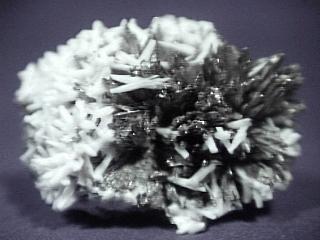
ARSENOPYRITE specimen ars-6
$ 95.00
$ 95.00
Dims: 2.6" x 2.0" x 1.5"(6.6 x 5.1 x 3.8 cm)
Wt: 7.38 oz.(209.3 g)
Huaron Mine, Ancash, Peru
Mostly Arsenopyrite by weight, this specimen consists of a cluster of hundreds of thin, spiky prismatic crystals. These spikes have an average length of 1/2"(1.3 cm) and have the bright silvery color and metallic luster for this mineral. They exhibit an almost acicular, radiating tendency, and are not all visible due to the presence of a tangle of intergrown calcite crystals on part of the cluster. The calcite crystals are pure white in color and have a spiky form that is similar to that of the Arsenopyrite. Actually, these crystals occur over all of the Arsenopyrites, but are concentrated in some areas. There is substantial damage to the cluster, though most of it is confined to the edges of the specimen where it was separated from its place of formation.

ars-6 ($ 95.00)
Huaron Mine, Ancash, Peru
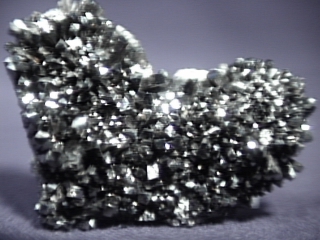
ARSENOPYRITE specimen ars-7
$ 30.00
$ 30.00
Dims: 1.8" x 1.5" x 0.6"(4.6 x 3.8 x 1.5 cm)
Wt: 1.74 oz.(49.4 g)
Canchaque Mine, Ancash, Peru
The aspect of this specimen that attracts me most is the fact that it is composed almost entirely out of Arsenopyrite. The specimen consists of a crust that is made up of scores of small orthorombic prismatic crystals with shallow dome terminations. They do not exceed 0.3" (8 cm) in length, and are in generally very good condition, with only about a dozen crystals showing damage or breakage. Their color is dark silver, and they have the standard metallic luster of most metal sulfides. The only other materials present are broken bits of quartz crystals and what appear to be some small patches of pyrite on the specimen's underside.

ars-7 ($ 30.00)
Canchaque Mine, Ancash, Peru
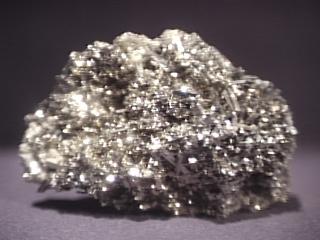
ARSENOPYRITE specimen ars-8
$ 100.00
$ 100.00
Dims: 3.3" x 2.0" x 1.3" (8.4 x 5.1 x 3.3 cm)
Wt: 8.27 oz. (234.6 g)
Huanzala Mine, Ancash, Peru
One of the neatest Arsenopyrite specimens that I have seen, this piece conatains dozens of long, thin, prismatic Arsenopyrite crystals with shallow, two-faced terminations. Interestingly, these crystals are not tapered like many Arsenopyrites that I have seen- they occur as long, thin orthorombic prisms. Many of the crystals in the cluster are damaged and broken, but at least as many are intact. The longest of these measures about 0.5" (1.3 cm). All have the standard silvery-gray color and metallic luster of Arsenopyrite. The base on which they rest is made up mostly of intergrown pyrite crystals that do not exceed 3 mm in diameter. There are a few clusters of tiny sphalerite crystals visible on the specimen's underside, too.
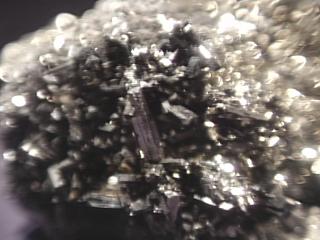

ars-8 ($100.00)
Huanzala Mine, Ancash, Peru

ARSENOPYRITE specimen ars-9
$ 31.00
$ 31.00
Dims: 2.7" x 2.3" x 1.7" (6.9 x 5.8 x 4.3 cm)
Wt: 9.95 oz. (282.2 g)
Zacatecas, Mexico
At least 15 intergrown pseudocubic Arsenopyrite crystals are clustered on this specimen. Many have noticeable damage on edges and corners, and a few on the specimen's edge are broken. The largest of these measures about 0.3"(7 mm) along an edge. Those that are intact have good form with well-defined edges and smooth faces that accentuate the crystals' metallic luster. They have the silvery-gray color of Arsenopyrite and are, of course, opaque. Accompanying the Arsenopyrite are clusters of tiny, white quartz crystals that show good hexagonal form but are mostly damaged. They only make up a small amount of the specimen's weight, however; it is composed mostly of the Arsenopyrite.

ars-9 ($ 31.00)
Zacatecas, Mexico

ARSENOPYRITE specimen ars-10
$ 45.00
$ 45.00
Dims: 1.8" x 1.2" x 1.1" (4.6 x 3.0 x 2.8 cm)
Wt: 1.95 oz. (55.3 g)
Santa Eulalia, Chihuahua, Mexico
This lovely thumbnail specimen consists of a small formation of Arsenopyrite. It is made up of scores of small crystals that do not exceed 0.2" (5 mm) in any dimension. They crystals are incomplete due to their intergrowth, but have excellent visible orthorombic form with clean faces and edges and only a small amount of damage. They have the standard, deep silver color and metallic luster that one expects of this mineral. Among the Arsenopyrite are several tiny, white quartz crystals that have good hexagonal prismatic form and moderate damage. They are dimly transparent and have a rather dull, pearly luster.
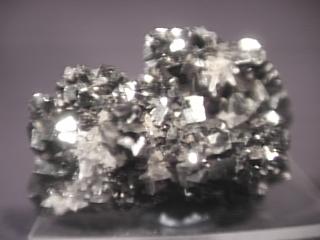

ars-10 ($ 45.00)
Santa Eulalia, Chihuahua, Mexico
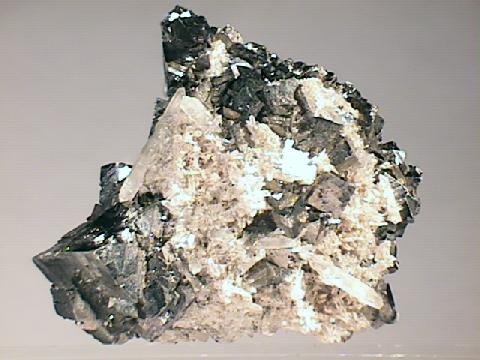
ARSENOPYRITE specimen ars-11
$ 70.00
$ 70.00
Dims: 1.8 x 1.8 x 1.2" (4.6 x 4.6 x 3.0 cm)
Wt: 4.06 oz. (115.1 g)
Santa Eulalia, Chihuahua, Mexico
This small hand specimen consists mostly of partly-intergrown Arsenopyrite crystals. The crystals are generally in very good condition, as a small number are damaged or broken. They reach dimensions of 0.6 x 0.4 x 0.3" (1.4 x 10.1 x 0.7 cm) and occur as pseudo-orthorhombic prisms. All have the classic silvery-gray color and metallic luster of their species, and are heavily intergrown with one another. They are accompanied by a druse of tiny quartz crystals that are mostly crushed and a few larger, intact ones.
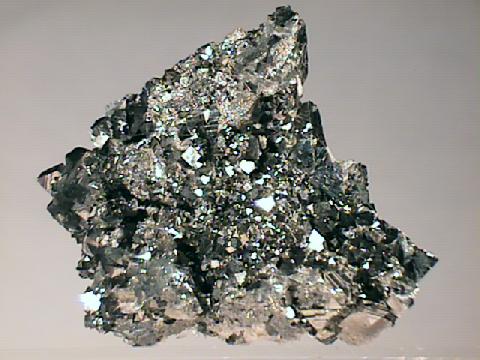

ars-11 ($ 70.00)
Santa Eulalia, Chihuahua, Mexico
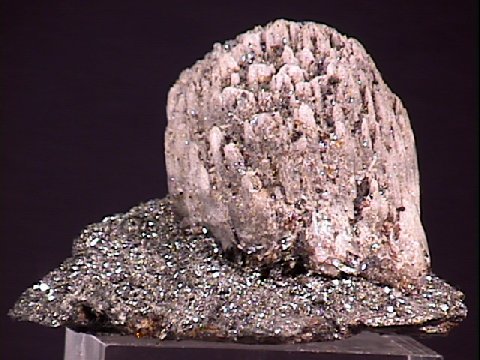
ARSENOPYRITE specimen ars-12
$ 30.00
$ 30.00
Dims: 2.0 x 2.0 x 1.4" (5.1 x 5.1 x 3.5 cm)
Wt: 2.8 oz. (80 g)
Huanzala Mine, Huanuco Department, Peru
Scores of tiny Arsenopyrite prisms are embedded in the sphalerite base of this hand specimen. These crystals do not exceed 0.1" (3 mm) in diameter but are in very good condition. Their orthorhombic form appears to be good, too, though they tend to be rather heavily embedded in the sphalerite. All have the bright, pale silvery-gray color and bright metallic luster of their specie. They are dwarfed by a large calcite crystal with an unusual termination.

ars-12 ($ 30.00)
Huanzala Mine, Huanuco Department, Peru
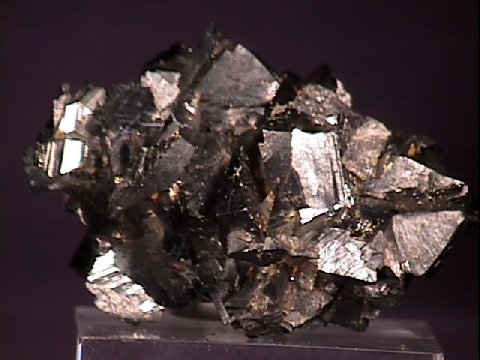
ARSENOPYRITE specimen ars-13
$ 84.00
$ 84.00
Dims: 1.9 x 1.2 x 1.1" (4.8 x 3.1 x 2.9 cm)
Wt: 2.6 oz. (73 g)
Santa Eulalia, Chihuahua, Mexico
This small hand specimen consists almost entirely of a cluster of intergrown, almost tabular Arsenopyrites. These crystals have visible lengths and widths of up to 0.6" (1.5 cm) and are generally in very good condition, though several are damaged (especially those on the underside of the piece). All have excellent orthorhombic form and the standard brassy white coloration and bright metallic luster on their striated surfaces. Only a small amount of a white, quartz host rock is present.

ars-13 ($ 84.00)
Santa Eulalia, Chihuahua, Mexico
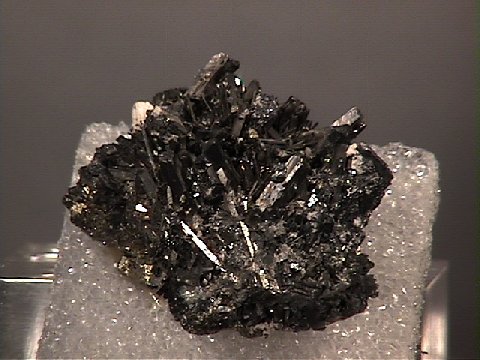
ARSENOPYRITE specimen ars-14
$ 48.00
$ 48.00
Dims: 1.2 x 1.0 x 0.6" (3.1 x 2.6 x 1.6 cm)
Wt: 1.0 oz. (28 g) w/ specimen box
Stratoni "M", Chalcidice, Greece
At least 20 tiny Arsenopyrite crystals rest on the metallic sulfide base of this thumbnail piece. These crystals are in fair condition- many are damaged or broken- and reach lengths of nearly 0.3" (8 mm). Their spiky, orthorhombic form is somewhat warped in several of the crystals, but is good in the rest of them. They have the moderate silvery-gray color and metallic luster that are standard for the specie. The piece is hot-glued into a plastic specimen box.

ars-14 ($ 48.00)
Stratoni "M", Chalcidice, Greece

ARSENOPYRITE specimen ars-15
$ 48.00
$ 48.00
Dims: 3.0 x 1.7 x 1.1" (7.6 x 4.4 x 2.7 cm)
Wt: 6.6 oz. (186 g)
Mina Noche Buena, Zacatecas, Mexico
This large hand specimen consists of a crystalline Arsenopyrite crust. The crystals that extend from the crust do not exceed 0.3" (8 mm) in length or 0.2" (5 mm) in diameter, but are generally in very good condition, showing little damage. Their orthorhombic prismatic form is excellent, showing sharp edges and clean faces. All have the classic pale silvery-gray color and metallic luster. A small amount of sphalerite is embedded in the crust, and there is no other base or host material present.

ars-15 ($ 48.00)
Mina Noche Buena, Zacatecas, Mexico

ARSENOPYRITE specimen ars-16
$ 48.00
$ 48.00
Dims: 2.8 x 2.3 x 1.2" (7.1 x 5.8 x 3.1 cm)
Wt: 5.3 oz. (151 g)
Moose River Gold Mine, Moose River, Nova Scotia, Canada
Four intersecting Arsenopyrite crystals rest on the finely layered base of this large hand specimen. These crystals reach dimensions of 0.9 x 0.9 x 0.5" (2.4 x 2.4 x 1.3 cm) and are in very good condition - one small one is damaged and the largest is broken and incomplete, but the luster of the breakage surfaces suggests that this occurred prior to mining. All have very good orthorhombic prismatic form and the classic silvery-white color and metallic luster of the specie. At least one other mineral is present in the base matrix - I cannot identify it, but it forms small concretions or nodules that have a white color and dull luster.

ars-16 ($ 48.00)
Moose River Gold Mine, Moose River, Nova Scotia, Canada

ARSENOPYRITE specimen ars-18
$ 65.00
$ 65.00
Dims: 3.8 x 2.3 x 1.9" (9.7 x 5.8 x 4.7 cm)
Wt: 8.8 oz. (249 g)
Moose River Gold Mine, Moose River, Nova Scotia, Canada
At least 13 distinct Arsenopyrite blades are partly embedded in the gray matrix rock of this cabinet specimen. These crystals are generally broken and incomplete, though a few are intact, and have visible dimensions of up to 0.8 x 0.8" (1.9 x 1.9 cm). All have a rather common orthorhombic form that is more bladed than prismatic, and several intersect with one another, suggesting some twinning. All have the silvery-gray coloration and bright metallic luster and are, of course, opaque. It appears that these crystals have been artificially exposed from their matrix rock, and perhaps a few other small crystals could be exposed through further erosion.
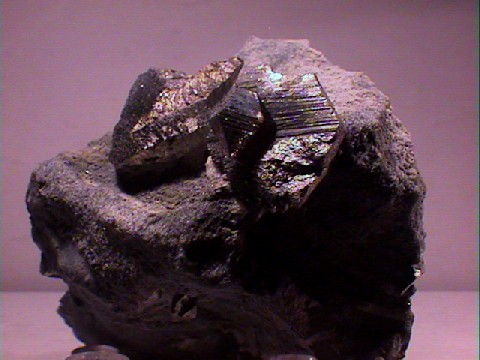

ars-18 ($ 65.00)
Moose River Gold Mine, Moose River, Nova Scotia, Canada
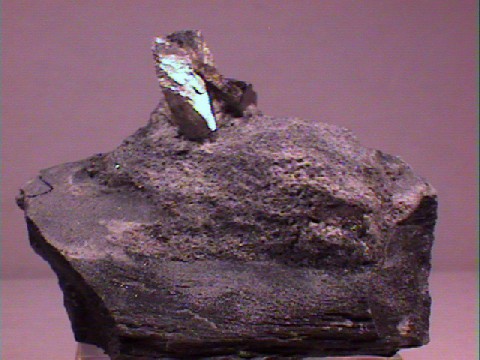
ARSENOPYRITE specimen ars-17
$ 25.00
$ 25.00
Dims: 1.8 x 1.2 x 1.1" (4.6 x 3.0 x 2.8 cm)
Wt: 1.5 oz. (42 g)
Moose River Gold Mine, Moose River, Nova Scotia, Canada
Two intergrown Arsenopyrite crystals rest on the black shale base of this hand specimen. Both crystals show considerable damage and are not quite complete, though said damage appears to be somewhat old. The larger has dimensions of 0.5 x 0.4 x 0.1" (1.3 x 1.0 x 0.3 cm), and the smaller is partially engulfed by its intersection with the larger. Both show excellent orthorhombic form that is nearly tabular in habit, and even with the damage show the classic diamond-shaped cross-section of the specie. Their silver-gray color and metallic luster are likewise expected. One or two other, broken crystals are almost completely embedded in the black shale matrix; they appear to have formed within said matrix.

ars-17 ($ 25.00)
Moose River Gold Mine, Moose River, Nova Scotia, Canada
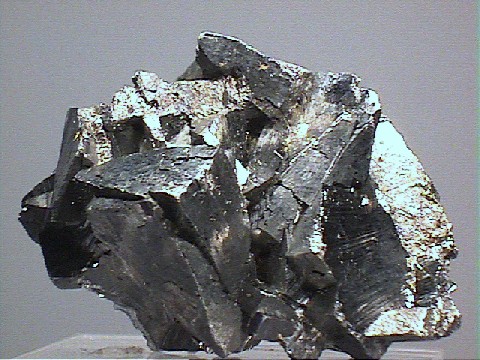
ARSENOPYRITE specimen ars-19
$ 36.00
$ 36.00
Dims: 1.5x1.1x1.0 " (3.9x2.9x2.5 cm)
Wt: 2.0 oz. (58 g)
Hidalgo del Parral, Chihuahua, Mexico
This small hand specimen is entirely arsenopyrite, in the classic twinned form that results in curved striated crystals. The specimen has some damage, primarily on the edges but also on some edges and points. However, the variety of curved surfaces along with the acute angles characteristic of arsenopyrite make this a pleasing specimen.

ars-19 ($ 36.00)
Hidalgo del Parral, Chihuahua, Mexico
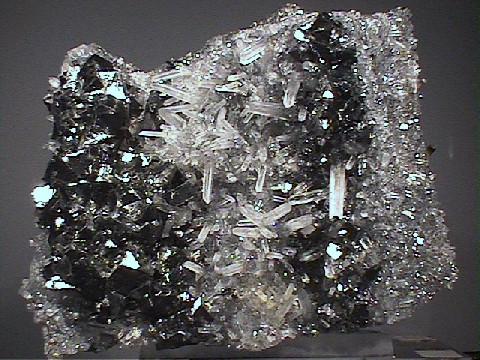
ARSENOPYRITE specimen ars-20
$ 75.00
$ 75.00
Dims: 3.1x3.2x3.1" (7.9x8.1x7.9 cm)
Wt: 1 lb 13.5 oz. (835 g)
Hubei, China
This small cabinet specimen consists of intergrown veins of quartz and arsenopyrite. On the surface, the quartz has the form of countless sprays of long, narrow crystals, and the arsenopyrite has the characteristic diamond-shaped terminations and silver color of this mineral. This is a very appealing specimen of arsenopyrite, even though the crystals are intergrown. There is very little damage to this specimen.
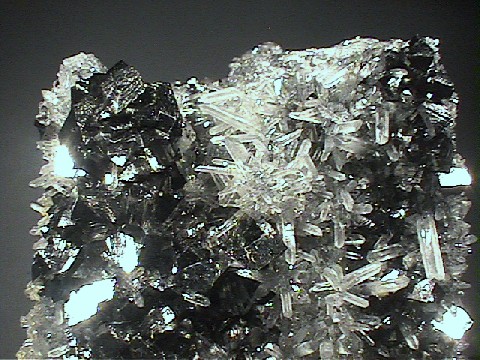

ars-20 ($ 75.00)
Hubei, China
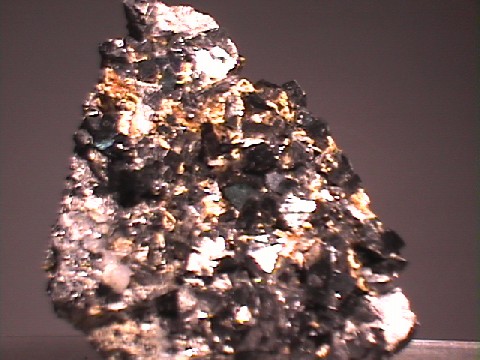
ARSENOPYRITE specimen ars-21
$ 45.00
$ 45.00
Dims: 2.8x1.3x1.6" (7.2x5.4x4.0 cm)
Wt: 9.0 oz. (255g)
Hubei, China
This hand specimen of arsenopyrite contains only small amounts of other minerals (a little quartz and a brown crust that looks like barite). The arsenopyrite crystals are well formed and clean, showing a variety of forms. Several twinned crystals are present (evidenced by curved crystals), and the largest crystal stands tall on the surface, rising over a centimeter above its base.

ars-21 ($ 45.00)
Hubei, China
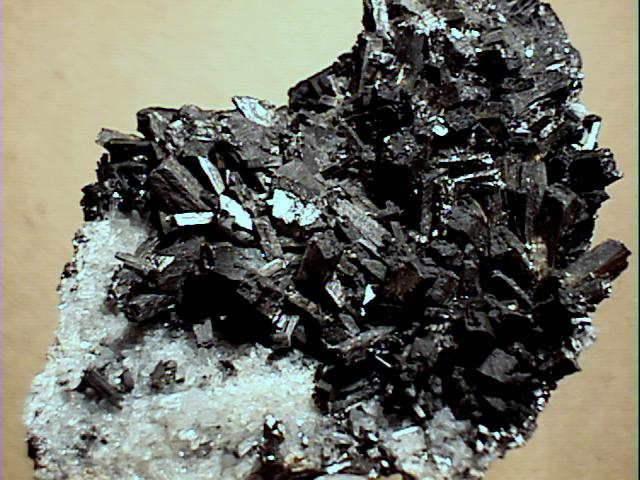
ARSENOPYRITE specimen ars-22
$ 60.00
$ 60.00
Dims: 2.65x1.77x0.80" (6.74x4.49x2.03cm)
Wt: 2.70oz (76.4g)
Quiruvilca, La Liberatd, Peru
This specimen displays perhaps one hundred arsenopyrite crystals which average 5 to 7mm in length and 2 to 2½mm in width. They have a rhombic cross section (many are diamond shaped), and the terminations display lots of facets at differing heights, giving a choppy appearance. While the sides of the crystals have a metallic luster, the terminations look dull. As is typical with these Peruvian specimens, there is a base of (likely) pyrite and quartz crystals, plus an admixture of other minerals. I can certainly identify some sphalerite, and I believe there is chalcopyrite and even some tiny bornite crystals.


ars-22 ($ 60.00)
Quiruvilca, La Liberatd, Peru